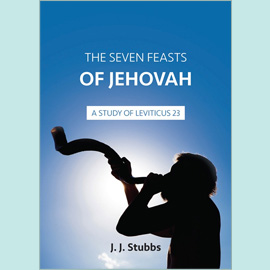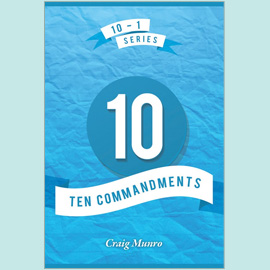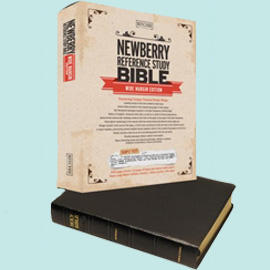
THE VEIL
The place and appearance of the veil
The veil is one of the most significant items to be found in the Tabernacle. The word "veil" means "curtain". It acted as a divider or "that which separates". It formed the division between the Holy Place and the Holiest of All. This beautiful curtain was made of fine twined linen and embroidered with blue, and purple, and scarlet thread. The embroidery included cherubims, although there is no indication of how many there were on the curtain. No dimensions were given for the veil, but, accepting that the width of the Tabernacle was ten cubits, the veil would measure ten cubits square (the boards were ten cubits high). Four pillars of shittim wood overlaid with gold were made on which the veil was hung. These pillars sat, not on two sockets of silver as did the boards, but each on one single socket. The reason why only one socket sat under these pillars, whereas two were under each of the boards, is that the pillars would not be as broad as the boards. The veil was hung on the pillars by means of golden hooks.
The pillars were placed so that the veil was hung "under the taches" (v.33). This refers to the taches which joined together the two curtains of fine twined linen, made from ten smaller curtains, forming the inner lining of the tabernacle roof (26.2-6). These curtains were twenty cubits long, forty cubits in total, and as the Tabernacle was thirty cubits in length and ten cubits high the taches joining the two curtains would be positioned twenty cubits from the door of the Holy Place and ten cubits from the rear, with the remainder of the curtains, a further ten cubits, falling down the rear. By this means it is established that the Holy Place was ten cubits in length as the veil was hung under the taches of gold joining the two curtains.
When it was time for Israel to move and follow the cloud, the veil covered the Ark. It would not be permissible to look on the Ark, only the High Priest ever enjoyed that privilege and only on the Day of Atonement, so the veil was taken down and the priests would advance towards the Ark holding the veil in front of them so that the Ark was not seen. It would then be placed over the cherubim and be draped over the Mercy Seat and the Ark. As it has been noted that the veil was ten cubits square there would be ample material to cover an ark which was 2 cubits long and 1 cubits broad. While it is granted that no height is given for the cherubim, the size of the Ark would indicate that they were not of great size, but would be in proportion to it. The other Ark coverings, which were placed over the veil, were a covering of badgers’ skins and a top covering of blue cloth (Num 4.5-6).
The significance of the veil
The veil was a constant reminder that although the Holy Place was where God was, entrance into His presence was not open to all. Passing through the veil was the prerogative of the High Priest and only annually, on the Day of Atonement (Lev 16). This was a lesson being taught throughout the history of the Tabernacle, the teacher being the Holy Spirit and the lesson being that the way into the Holiest was not yet open: "The Holy Ghost this signifying, that the way into the holiest of all was not yet made manifest, while as the first tabernacle was yet standing" (Heb 9.8).
What kept man out? Sin was the reason! All service of the Tabernacle looked forward to Him who would meet the need and enable man to enter, but, as the Hebrew writer states, the way into His presence was not yet manifest. What joy to read not yet and not the awful words not ever. The Tabernacle was a picture and a parable, but, although its service could not gain worshippers access to His presence, it pictured a coming day when that would be open.
But the veil was rent (Mt 27.51; Mk 15.38; Lk 23.45). As the Lord Jesus "yielded up the ghost" (Mt 27.50) that great veil in the Temple built by Herod was completely torn asunder, proclaiming that the way into His presence had been made manifest. The Hebrew Epistle deals with this great privilege: "Having therefore, brethren, boldness to enter into the holiest by the blood of Jesus, By a new and living way, which he hath consecrated for us, through the veil, that is to say, his flesh" (Heb 10.19-20). The reader must first understand that "boldness" is not arrogance, nor is it casualness. The fact that the way is now open may lead to unacceptable behaviour, if not to an arrogant approach, equally shamefully to a casual approach. "Boldness" means "freely", "with confidence", and "with assurance".
The vital point to grasp is that it is the "new and living way" that is referred to as "his flesh". By Him becoming a man and enduring the Cross, He has not only opened up the new and living way, He is the new and living way. It is through Him that worshippers enter the Holiest of All. Just as it was not possible to see the glory in the Holiest unless the veil was passed, so today worshippers cannot see into the third heaven, into that heavenly sanctuary. But it is possible for them to move from the seen into the unseen, from the earthly to the heavenly. He is the new and living way, and by Him those who approach God enter into the holiest "by the blood of Jesus".
But the writer of Hebrews has more to say about the significance of this veil. He states that believers have a hope "which…we have as an anchor of the soul, both sure and stedfast, and which entereth into that within the veil" (Heb 6.19). Christians have a hope which is completely secure and which never will be lost. This is a hope of enjoying all the glory that is associated with the Lord Jesus Christ; it is the eternal glory to which all believers are travelling. The picture presented is of the rough boisterous passage of life, like a storm tossed boat, but a boat with an anchor - one that is firmly fixed in glory, within the veil. This anchor is imbedded, firmly settled, and incapable of slipping, one on which complete reliance can be placed.
But where is "within the veil"? It is where the Lord Jesus Christ has already entered. The anchor is where He is, for He is the anchor and the guarantee that believers will enter where He has gone. He entered there as a forerunner. The High Priest of Israel entered the Holiest of All but not as the forerunner of Israel, for access there would never be opened to all the people. He entered representing the people, but the Lord entered, not only to represent, which He does as the Great High Priest, but also as One who is in advance of others who will follow. Note that "the forerunner is for us entered, even Jesus, made an high priest after the order of Melchisedec" (Heb 6.20).
Thus, today, the believer rejoices in two things. First, entrance into His presence is freely available now. "Let us therefore come boldly unto the throne of grace" (Heb 4.16) is the exhortation to be heeded. No barrier exists now. Second, this present access is but a foretaste of the day when, after death or rapture, the believer will enter His presence, following the forerunner - He who has blazed the trail and gone before.
A vital lesson from the rent veil
Men enjoy "religion" with its robes, vestments, incense, altars, priesthood, and enthronements. They love the "churches", abbeys, and cathedrals with their glorious stained glass windows and soaring galleries. They relish the altar with its railings and gates, designating the altar area as being only for the "priests", with entrance barred to the "laity". All this appeals to the flesh and is guarded jealously by those who are "ordained" into such "high calling and privilege". But the veil has been rent! All believers now have access. The religious trappings of such systems are meaningless and empty. There are no veils now, no railings around altars, no ground on which only "ordained priests" can walk, and no places where the feet of "laity" cannot stand. Such practices and symbolism are worthless, denying the great truth that the way is now manifest and all can come boldly to the Throne of Grace.









